Articles: Adoranten 2020
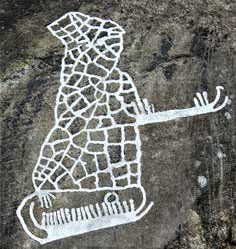 White-foamed waves violently crash into the rugged coast. Underneath the water darkness plunges to unknown depths. To those sailing its waters the sea is an expedient passageway providing fishermen with an abundance of sustenance. Yet, treacherous rocks in shallow water lure ships to crash and strong currents bring even the most competent swimmers down. Still today, we do not know exactly what lurks in the depths. As an entity the sea is drenched with danger, death and the unknown. This contrast implies that the sea had an important role in the cosmologies of prehistoric societies.
Decades of research suggests that worldview in the Nordic Bronze Age was closely tied to the cyclical voyage of the sun through the cosmos. The sun did not only trail through the sky, it also dropped under into the sea. At the horizon the controllable world ended, and sky, earth and sea met (Kaul 2005, 2004). Bronze Age Scandinavian society relied heavily on a maritime mobility and this is unmistakably visible in rock art (Ling 2014; Milstreu 2018). With over 19,000 examples, ships are by far the most common motif on the smooth granite rocks of Southern Scandinavia and the carvings appear to have a communicative location near the ancient shoreline (Goldhahn and Ling 2013; Ling 2008). However, not only did the sea provide Bronze Age society with resources, it was also a dangerous place linked to death and the unknown (see Horn 2016). Likely, only a few people in Bronze Age Scandinavia had swimming abilities and thus ending up in the water was often fatal. This idea of the sea as a dangerous and unpredictable place needs to be explored more in-depth in rock art research.
White-foamed waves violently crash into the rugged coast. Underneath the water darkness plunges to unknown depths. To those sailing its waters the sea is an expedient passageway providing fishermen with an abundance of sustenance. Yet, treacherous rocks in shallow water lure ships to crash and strong currents bring even the most competent swimmers down. Still today, we do not know exactly what lurks in the depths. As an entity the sea is drenched with danger, death and the unknown. This contrast implies that the sea had an important role in the cosmologies of prehistoric societies.
Decades of research suggests that worldview in the Nordic Bronze Age was closely tied to the cyclical voyage of the sun through the cosmos. The sun did not only trail through the sky, it also dropped under into the sea. At the horizon the controllable world ended, and sky, earth and sea met (Kaul 2005, 2004). Bronze Age Scandinavian society relied heavily on a maritime mobility and this is unmistakably visible in rock art (Ling 2014; Milstreu 2018). With over 19,000 examples, ships are by far the most common motif on the smooth granite rocks of Southern Scandinavia and the carvings appear to have a communicative location near the ancient shoreline (Goldhahn and Ling 2013; Ling 2008). However, not only did the sea provide Bronze Age society with resources, it was also a dangerous place linked to death and the unknown (see Horn 2016). Likely, only a few people in Bronze Age Scandinavia had swimming abilities and thus ending up in the water was often fatal. This idea of the sea as a dangerous and unpredictable place needs to be explored more in-depth in rock art research.
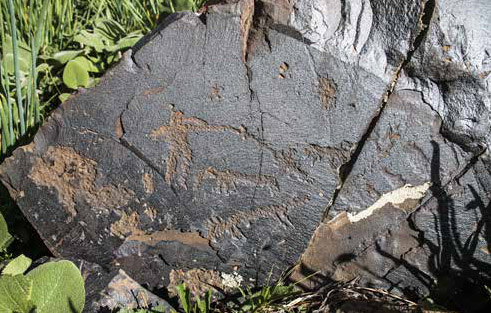 Saimaluu-Tash is located in the center of Kyrgyzstan, circa 40 km south of Kazarman, on the eastern slope of the Fergana range. The main site (called Saimaluu-Tash 1, fig.1) is situated at 3,100m a. s. l. and has been documented in the past 30 years, even if there is no whole publication on it (Martynov et alii 1992; Tashbaeva et alii 2001). A second site (Saimaluu-Tash 2) is located northeast of the main site at an altitude of 3,300m (Fig.2). This site was almost never documented nor published.
In our prospections between 2013 and 2017, 2,320 engraved rocks were documented in Saimaluu-Tash 1 and 1,550 in Saimaluu-Tash 2. The petroglyphs are mainly dated from the Bronze Age, but many are also from the Iron Age and from the Turkic medieval time.
Both sites are important for the study of rock art in Central Asia, not only due to the large amount of drawings, but also for the diversity of the iconography as well as for the fact that some drawings which are very rare at other sites were frequently found in Saimaluu-Tash, such as ploughs and the so-called sunhead-deities. During our research, we found some panels with anthropomorphs keeping a dog on a leash. Although we documented 13 sites in the provinces of Almaty and Zhambyl in Southeastern Kazakhstan and 24 sites in Kyrgyzstan, we only found this kind of petroglyph in Saimaluu-Tash.
Saimaluu-Tash is located in the center of Kyrgyzstan, circa 40 km south of Kazarman, on the eastern slope of the Fergana range. The main site (called Saimaluu-Tash 1, fig.1) is situated at 3,100m a. s. l. and has been documented in the past 30 years, even if there is no whole publication on it (Martynov et alii 1992; Tashbaeva et alii 2001). A second site (Saimaluu-Tash 2) is located northeast of the main site at an altitude of 3,300m (Fig.2). This site was almost never documented nor published.
In our prospections between 2013 and 2017, 2,320 engraved rocks were documented in Saimaluu-Tash 1 and 1,550 in Saimaluu-Tash 2. The petroglyphs are mainly dated from the Bronze Age, but many are also from the Iron Age and from the Turkic medieval time.
Both sites are important for the study of rock art in Central Asia, not only due to the large amount of drawings, but also for the diversity of the iconography as well as for the fact that some drawings which are very rare at other sites were frequently found in Saimaluu-Tash, such as ploughs and the so-called sunhead-deities. During our research, we found some panels with anthropomorphs keeping a dog on a leash. Although we documented 13 sites in the provinces of Almaty and Zhambyl in Southeastern Kazakhstan and 24 sites in Kyrgyzstan, we only found this kind of petroglyph in Saimaluu-Tash.
 At many places in the Danish countryside, you can find boulders in the landscape, glacial erratics, transported by the ice of the last glaciation from more mountainous regions north and northeast of Denmark. Only the Baltic island of Bornholm has its own solid rocks. Just minor portions of those boulders remain where the glaciers left them. The stones were used in the thousands of megalithic tombs erected in Denmark during the Neolithic, between 3600 and 3200 BC, and more stones were used as kerb-stones of Bronze Age mounds. Large scale Medieval church building activity took further toll on the stone material left in the landscape, as well as renaissance manors and castles.
Still, many smaller and larger stone blocks can be seen in the landscape, some being the last remains of megalithic tombs of the Neolithic, others being used as menhirs, while quite some are seemingly still resting in their original position. Due to the intensive and systematized collection of Danish folklore material during the second half og the 19th century and early parts of the 20th century, we are well acquainted with tales, traditions and legends related to these sacred stones (for instance: Tang Kristensen 1892-1901 & Schmidt 1933) – stones, most of which can be seen and studied in their geographical context today.
At many places in the Danish countryside, you can find boulders in the landscape, glacial erratics, transported by the ice of the last glaciation from more mountainous regions north and northeast of Denmark. Only the Baltic island of Bornholm has its own solid rocks. Just minor portions of those boulders remain where the glaciers left them. The stones were used in the thousands of megalithic tombs erected in Denmark during the Neolithic, between 3600 and 3200 BC, and more stones were used as kerb-stones of Bronze Age mounds. Large scale Medieval church building activity took further toll on the stone material left in the landscape, as well as renaissance manors and castles.
Still, many smaller and larger stone blocks can be seen in the landscape, some being the last remains of megalithic tombs of the Neolithic, others being used as menhirs, while quite some are seemingly still resting in their original position. Due to the intensive and systematized collection of Danish folklore material during the second half og the 19th century and early parts of the 20th century, we are well acquainted with tales, traditions and legends related to these sacred stones (for instance: Tang Kristensen 1892-1901 & Schmidt 1933) – stones, most of which can be seen and studied in their geographical context today.
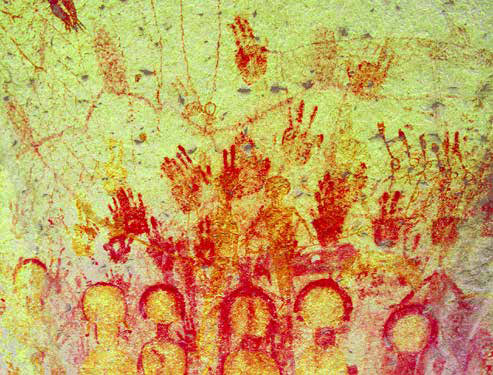 The long persistence of ancient traditions in India, with the continuance of ritual practices in painted shelters, including handprints, enables us to better understand some of the reasons that may have prompted the authors of handprints in the rock art of the region under study.
The long persistence of ancient traditions in India, with the continuance of ritual practices in painted shelters, including handprints, enables us to better understand some of the reasons that may have prompted the authors of handprints in the rock art of the region under study.
Among the sixty-four rock art sites known in the State of Chhattisgarh (India), 750 handprints can be seen on their walls. In seven cases the hands are negative (stencils).
Handprints may also be found in villages on the walls of houses. They are thought to establish a direct relationship between this world and the next. They are perceived by local people as a protection, not as a signature or a casual gesture. Footprints on rock art walls, occasionally associated with handprints, are more rare and have different meanings according to the places where they were made.
If handprint representations are common the world over, in India, and particularly in the region under study, age-old traditions of handprint making are still alive in many places. In certain parts of the State, auspicious prints made on the walls at the house entrance and sometimes on the wall inside the house represent the hands of Lakshmi, the Goddess of Wealth.
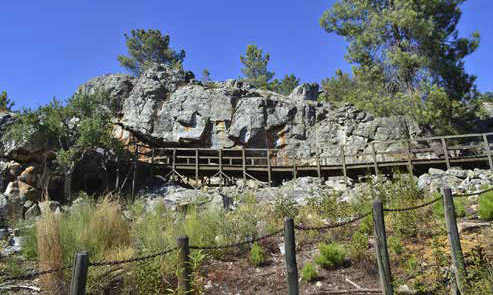 In the current Portuguese territory, the iconographic representations of the 3rd millennium BC are characterized by their technical and typological diversity, occurring in the most varied backdrops and with formal characteristics that adapt to specific archaeological contexts. The schematism intrinsic to these representations often prevents us from carrying out a formal and interpretive classification, with human and animal motifs being more easily recognizable due to their formal characteristics, beside the anatomical details scarcely represented. In zoomorphs, the existence of stems or antlers, tails, or fur, as well as the morphological characteristics of the animal’s body allow us, in some cases, to differentiate animal species, with the red deer being classified in this category. In this work we will present some examples of schematic representations of red deer in portable artefacts and natural rock formations, starting from a scene present in Lapa dos Gaivões to the representations present the Vila Nova de São Pedro’s loom plates/weights.
In the current Portuguese territory, the iconographic representations of the 3rd millennium BC are characterized by their technical and typological diversity, occurring in the most varied backdrops and with formal characteristics that adapt to specific archaeological contexts. The schematism intrinsic to these representations often prevents us from carrying out a formal and interpretive classification, with human and animal motifs being more easily recognizable due to their formal characteristics, beside the anatomical details scarcely represented. In zoomorphs, the existence of stems or antlers, tails, or fur, as well as the morphological characteristics of the animal’s body allow us, in some cases, to differentiate animal species, with the red deer being classified in this category. In this work we will present some examples of schematic representations of red deer in portable artefacts and natural rock formations, starting from a scene present in Lapa dos Gaivões to the representations present the Vila Nova de São Pedro’s loom plates/weights.
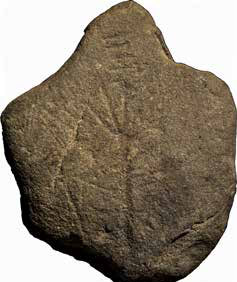 Skepticism is, in many ways, a reasonable attitude towards the act of interpreting prehistoric rock art. Can we even begin to hope to uncover the original intent behind the creation of the various petroglyphs and, in continuation hereof, each motif’s associated meaning(s)? Could it be that the mind of modern man simply is not wired to comprehend the flow of thoughts and reasoning of our distant ancestors? The validity of such questions is hard to dispute. I would argue, however, that if we were to declare the mystery of the prehistoric motifs unsolvable and turn our attention towards other, more measurable, research fields, we would be neglecting our responsibility as archaeologists. Unless we wish to return to old customs where a petroglyph is merely identified, registered and then left to itself (Tilley 1991, 11 f.), it is our duty as archaeologists to try and discover any traceable logic stored in the prehistoric iconography – however inconceivable the task may seem at first. Because if we do not, no one will. We cannot hope to reach a point where we can claim to have solved the puzzles of the petroglyphs in their entirety, but with every plausible interpretation committed to the study of their symbolism we move closer to a better understanding of their raison d’être.
Skepticism is, in many ways, a reasonable attitude towards the act of interpreting prehistoric rock art. Can we even begin to hope to uncover the original intent behind the creation of the various petroglyphs and, in continuation hereof, each motif’s associated meaning(s)? Could it be that the mind of modern man simply is not wired to comprehend the flow of thoughts and reasoning of our distant ancestors? The validity of such questions is hard to dispute. I would argue, however, that if we were to declare the mystery of the prehistoric motifs unsolvable and turn our attention towards other, more measurable, research fields, we would be neglecting our responsibility as archaeologists. Unless we wish to return to old customs where a petroglyph is merely identified, registered and then left to itself (Tilley 1991, 11 f.), it is our duty as archaeologists to try and discover any traceable logic stored in the prehistoric iconography – however inconceivable the task may seem at first. Because if we do not, no one will. We cannot hope to reach a point where we can claim to have solved the puzzles of the petroglyphs in their entirety, but with every plausible interpretation committed to the study of their symbolism we move closer to a better understanding of their raison d’être.
 In this article, we argue that efforts aimed at understanding some of the main features of the maritime system that emerged in Scandinavia during the Bronze Age, such as the social organization behind the building and crewing of boats along with the making of rock art boats in the landscape, would greatly benefit from the incorporation of cross-cultural and interdisciplinary approaches. Thus, this article seeks to understand the role that watercraft technology, rock art and long distance maritime exchange played in the development of social complexity in Scandinavia during the Bronze Age by way of cross-cultural comparison with the Haida of North America. While occupying different chronological and ecological settings, both culture areas shared numerous similarities. The Haida of the Northwest Coast and Scandinavian Bronze Age societies were ranked, engaged in long distance maritime exchange, waged war, possessed seaworthy watercraft technology capable of transporting large numbers of people along with heavy cargoes over long distances, and created rock art. Moreover, the carving of rock art was part of the ritual activity required for admission into certain secret societies among Northwest Coast peoples. Furthermore, slavery constituted a major component of the Haida political economy and some scholars argue that this also could have been the case in Bronze Age Scandinavia. Before we proceed with this topic, however, we must emphasize some theoretical aspects of comparative approaches.
In this article, we argue that efforts aimed at understanding some of the main features of the maritime system that emerged in Scandinavia during the Bronze Age, such as the social organization behind the building and crewing of boats along with the making of rock art boats in the landscape, would greatly benefit from the incorporation of cross-cultural and interdisciplinary approaches. Thus, this article seeks to understand the role that watercraft technology, rock art and long distance maritime exchange played in the development of social complexity in Scandinavia during the Bronze Age by way of cross-cultural comparison with the Haida of North America. While occupying different chronological and ecological settings, both culture areas shared numerous similarities. The Haida of the Northwest Coast and Scandinavian Bronze Age societies were ranked, engaged in long distance maritime exchange, waged war, possessed seaworthy watercraft technology capable of transporting large numbers of people along with heavy cargoes over long distances, and created rock art. Moreover, the carving of rock art was part of the ritual activity required for admission into certain secret societies among Northwest Coast peoples. Furthermore, slavery constituted a major component of the Haida political economy and some scholars argue that this also could have been the case in Bronze Age Scandinavia. Before we proceed with this topic, however, we must emphasize some theoretical aspects of comparative approaches.
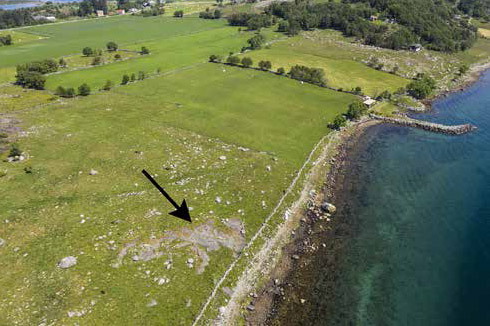
Status quo, ongoing challenges, and future perspectives - after more than 20 years of practice in rock art documentation, conservation, and management in southwestern Norway by Torbjørg Bjelland and Gitte Kjeldsen
The county Rogaland, in southwestern Norway, has identified 186 rock art sites. The majority are large concentrations of open-air localities in a maritime environment, as well as boulders with carvings. In addition, one rock painting site has been registered in Rogaland (Høgestøl et al. 2018).
In 1995, the Directorate for Cultural Heritage prepared a status report, “Plan for Measures to be Taken to Preserve Rock Art”. The report concluded that approximately 92% of the Norwegian’s rock art sites have major damages (Directorate for Cultural Heritage 1995). Based on this report, the Ministry of the Environment allocated funds for a national project for the conservation and safeguarding of Norwegian rock art. The Norwegian Directorate for Cultural Heritage’s national project formally started in 1996, it was called Protection of Rock Art – The Rock Art Project (Hygen 2006). The aims of the project plan included condition and damage registration, documentation, preservation, and management strategies (Hygen 2006). The Norwegian University museums have continued their work with rock art until today (Kjeldsen 2012).
During the project, the Museum of Archaeology, University of Stavanger (AMUiS), built up expertise in several fields, with a particular focus on jointing methods , conservation of rock and documentation. The work has been organized into an interdisciplinary group of archaeologists, botanists, curators, meteorologists, as well as an external geologist.
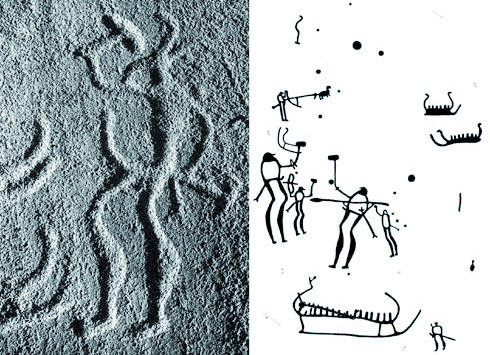
In this article, we employ an interdisciplinary approach to explore the possibility that Scandinavian Bronze Age rock art was created by warrior-trader secret societies as part of the ritual practices associated with long distance exchange activities. Additionally, we suggest that secret societies may have been responsible for the creation and maintenance of a Supra Regional Network that linked the Limfjord/Jutland and Tanum/Bohuslän areas together in Western Scandinavia. In short, we propose that rock art depictions of warriors represent individuals engaging in activities and rituals conducted by secret societies. Interestingly, these warrior images are often accompanied by depictions of supernatural beings, large ships, the wearing of ritual gear especially with birdlike attributes, bi-horned helmets, masks, and other exotic items characteristic of secret societies. In addition to being a boat building location, we posit that the Tanum/Bohuslän area was also an ancient secret society pilgrimage location. These assertions are supported by ethnohistoric and ethnographic observations from various groups in which the relationship between secret societies and the creation of rock art is firmly established. Additionally, we suggest that ethnographic analogies can help to explain some of the rather enigmatic Scandinavian Bronze Age feature, often located close to the Bronze Age shore line, commonly referred to as ‘cooking pits’

|

